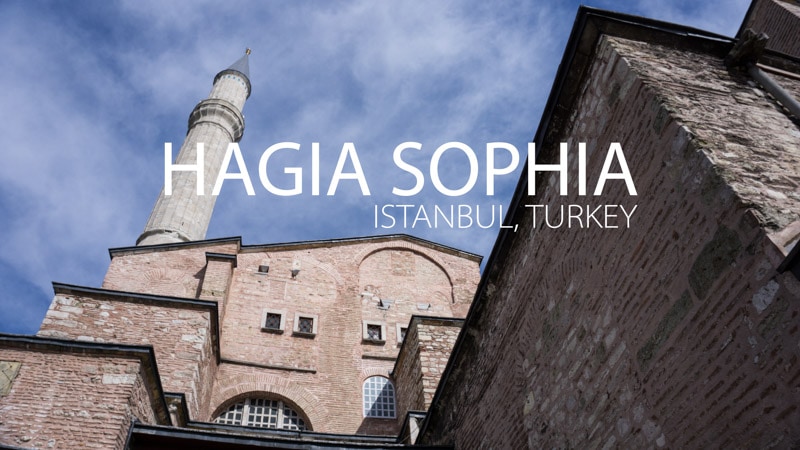
The Hagia Sophia in Istanbul, Turkey is one of the most beautiful structures in the world. Words can’t describe how I felt when I walked inside the nave, of interior of the church. It was so truly jaw dropping and unbelievable that all I could do was stop and stare. The grand interior was overwhelming and didn’t seem real. The experience was truly fantastic and something I will never forget.
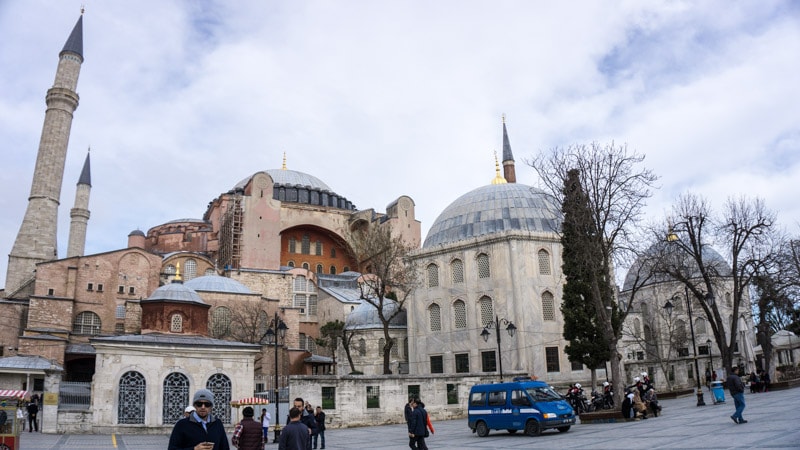
If you have never been to Istanbul, you should add this must see city, and Hagia Sophia to your travel bucket list right away.
And now for a little history lesson:
Hagia Sophia was built by Emperor Justinian in only five years between 532 and 537. This amazing structure was one of the greatest architectural achievements of the Byzantine Empire and the world. For some 900 years, the church served as the seat of the Ortodox Patriarch of Constantinople.
In 1453, Constantinople fell to the Ottomans and Sultan Mehmet the Conqueror. Mehmet, impressed with the grand church, converted Hagia Sophia into an imperial Mosque. Hagia Sophia remained the most important mosque in Istanbul for almost 500 years.
In the 1930s, the building was converted once again from a mosque into a museum. The museum now preserves the building and its unique and fascinating history of East and West, Byzantine Empire and Ottoman Empire, and Christianity and Islam.
After you pass through security and the ticket takers, hook a right towards the large fountain.
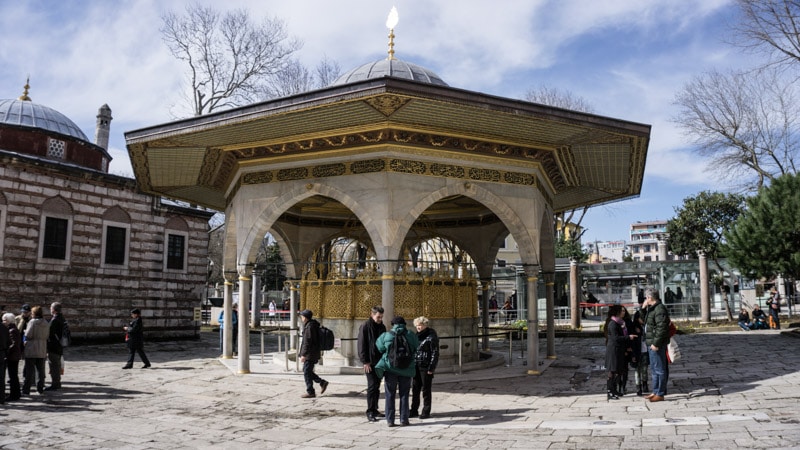
This beautiful roccoco, or “Late Baroque” fountain was built in the 18th century by the Ottomans.
The fountain, and nearby water taps, were used by worshipers at the mosque to clean themselves before prayer.
From the fountain, head towards the exit door to continue the tour.
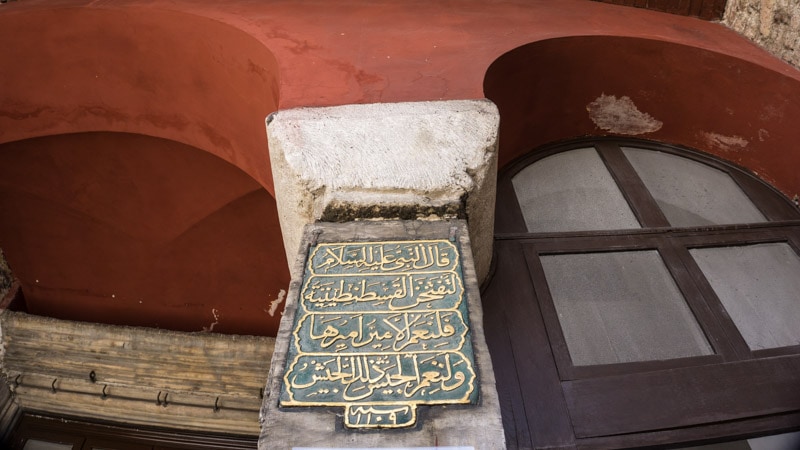
On the pillar just before the exit door, look out for the plaque with a quote of Muhammad translated from Arabic to Turkish.
The plaque reads:
“Constantionple [Istanbul] shall be surely conquered; how blessed the commander who will conquer it, how blessed his army.”
On May 29, 1452, Muhammad’s prediction came true as Constantinople fell to the Ottomans marking the end of the Byzantine Empire and possibly the end of the Middle Ages.
Just past the pillar, before you enter Hagia Sophia, turn to the right and into the small courtyard and walk to the marble pool.
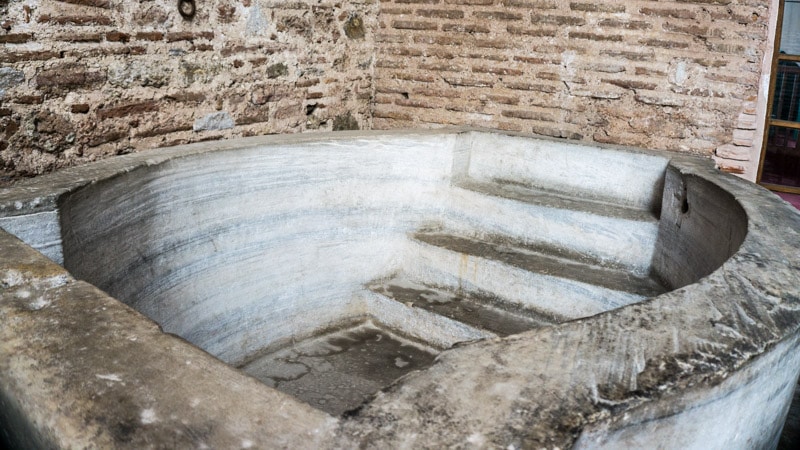
This large baptismal pool was cut out of a single piece of marble. The pool, which measures ten feet long and four feet deep, is in surprisingly good condition considering it was buried for centuries until being unearthed in 2010.
The pool was used for communal baptisms, common in early Christianity. Urns found nearby were filled with olive oil which was added to the water during baptisms.
If you are curious, you are probably wondering why the baptismal pool is located outside in the courtyard. Turns out the baptistery was actually located next door. The original baptistery was converted into the tomb of Sultan Mustafa I after his death in 1639.
Exit the courtyard the way you came in back towards the exit door of the museum. Walk though the door into the Vestibule of Guards.
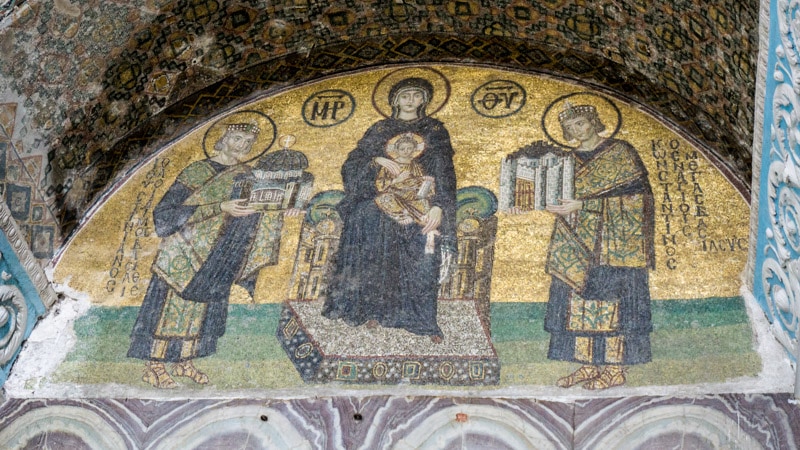
The Vestibule of Guards is an entryway of Hagia Sophia once used by imperial guards protecting the emperor while he was attending church services. The emperor would use this entry due to its proximity to the royal palace.
Look out for the mosaic above the doorway leading into the church.
This mosaic, known as the Donation Mosaic, dates back to the 11th century during the reign of Basil II. Thankfully, the mosaic has survived as many pieces of art were destroyed during the Iconoclast Era in the 6th and 7th centuries.
Mosaics like this were common in Orthodox churches. The mosaics usually depicted the patron who funded the construction of the church along with those who the church was dedicated to.
In the center of the mosaic is Mary who is holding the Child Christ. Jesus holds the Gospels in his left hand while making the sign of Trinity with his right hand.
To the right of Mary is Constantine holding a model of his walled city. On the left is Justinian, holding a model of Hagia Sophia, one of his great achievements. If you look closely, you might notice that Justinian’s model features no minarets or walls as seen today.
Continue past the Donation Mosaic into the Interior Narthex.
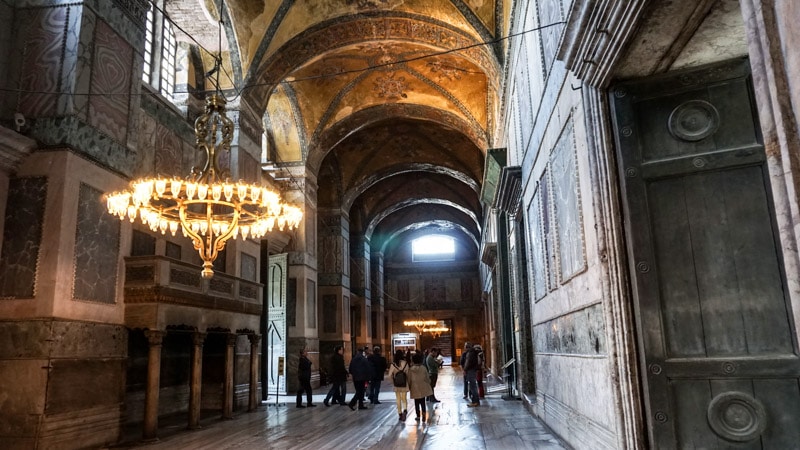
Through the door, just past the Donation Mosaic, leads you into the Interior Narthex.
This attractive and open space features nine valtued bays decorated by mosaics. The walls on both sides are lined with thick marble panels glued to the walls with stucco and iron rods.
Over the years, the iron has rusted and parts of the marble have fallen off the wall. Some of the walls, such as the Vestibule of Guards, have since been painted over to replicate the original marble walls.
Look up at the ceiling. These non-figurative mosaics designed by Anthemius are original Justinian mosaics that survived the Iconoclast Era. These mosaics were designed in a way to give the impression of movement thanks to randomly placed stones that change shades depending on the direction of sunlight or candlelight.
Just in front of you, look out for the large door leading into the nave. This is the Imperial gate.
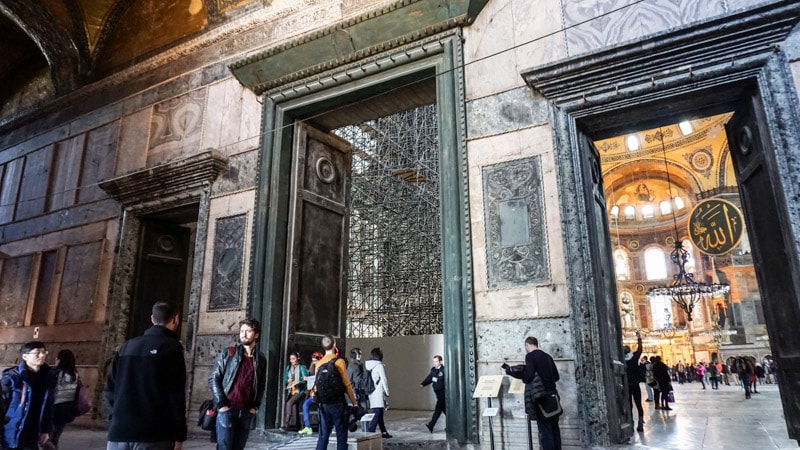
This magical doorway, known as the Imperial Gate, was reserved for the emperor. The door was only opened for him.
If you look closely at the top of the doorway you will notice multiple metal hooks. These hooks were used to hold leather curtains which protected worshipers from dust and from the interruption of the door being opened and closed. Curtains hung from these hooks are similar to those used in mosques today.
Continue through the Imperial Gate into the jaw dropping nave of Hagia Sophia.
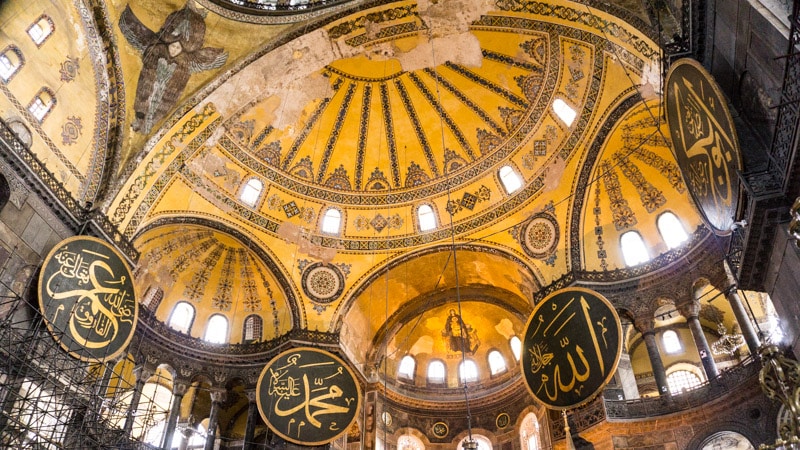
Passing through the grand Imperial Gate brings you into the nave of Hagia Sophia.
Wow. That’s how I can only describe it.
When I walked into this massive space, I was at a loss of words. It was truly magnificent. I had trouble comprehending how such a massive structure could have been built by the hands of man almost 1,500 years ago.
I now understand why the Hagia Sophia is the greatest architectural achievement of the Byzantine Empire.
Look up to see the massive main dome of the nave.
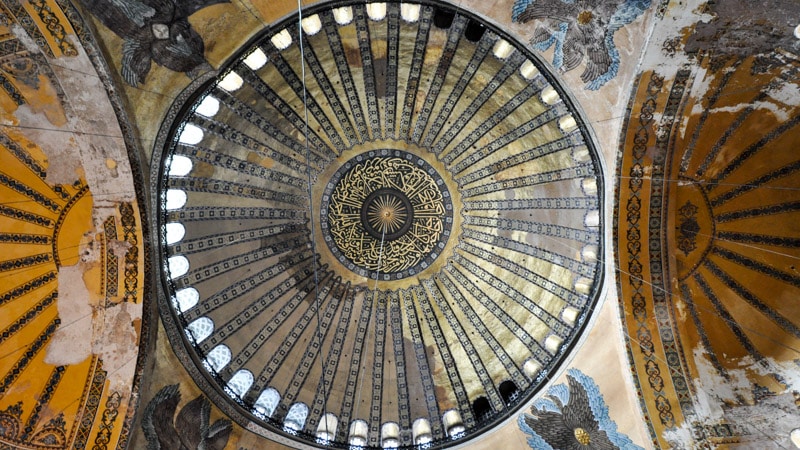
The main dome of Hagia Sophia, which almost appears to be floating on arches, is 185 feet high and about 105 feet in diameter.
At the base of the dome are small arched windows. These windows help pass the weight of the dome to massive piers at the corners of the building. In addition, over 100 columns provide the support needed for the dome. Many of the columns were brought here from other ancient monuments and temples
During its construction, the two geometricians had doubts about the construction. They were right. Part of the dome collapsed after its completion. It collapsed again in the 6th and 10th centuries. All three times, the dome was repaired
When Hagia Sophia was used as a mosque, decorations and mosaics depicting people were covered over with plaster. In an ironic twist of fate, the plaster helped preserve the artwork.
If you lookan see winged closely at the base of the dome, you will see winged seraphim that were once covered up. Their faces, except for one, are covered in gold masks.
You might also be wondering about the large black and gold circular medallions hanging from the bases of the arches. These medallions, added in the 19th century, are beautifully decorated in Arabic by master Islamic calligraphers. Writings like these are common in mosques as depictions of people are forbidden.
Walk towards the front of the church until you see an interesting decorated staircase.
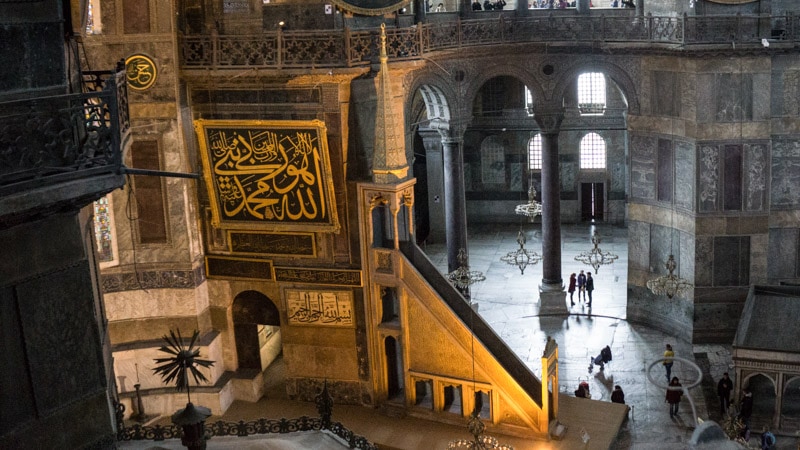
This staircase is known as a mimber. What exactly is a mimber?
That strange looking incline located in the center of the nave is known as the mimber. A mimber is a pulpitch, known as or raised platform used by the imam, or cleric, to deliver his sermon or talk to the public.
The imam stands halfway up the stairs of the mimber while delivering his sermon. Going any further up the stairs would be considered disrespectful towards the Prophet Muhammad.
Just pass the mimber, face the front of the church. This section is known as the apse. From here, look up at golden mosaic on the dome.
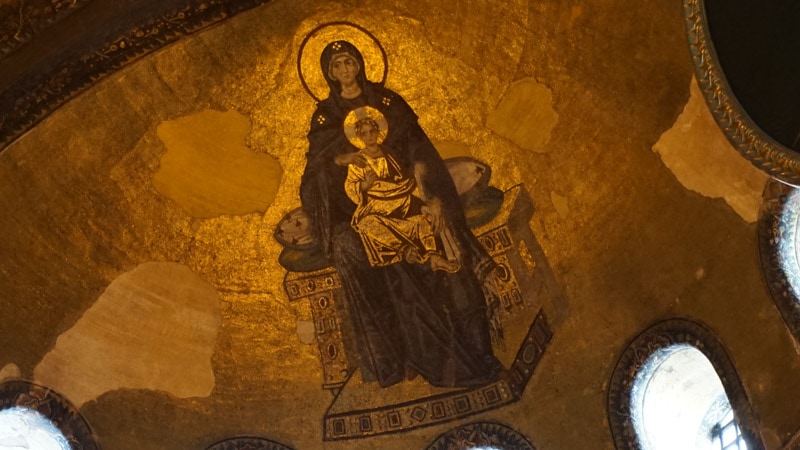
High above the apse, on one of the semi-domes, is the colorful Mosaic of Mary the Child Christ.
Though parts of the mosaic are missing, most is intact. This is surprising since the decoration dates back to the 9th century, making it the oldest mosaic in Hagia Sophia.
In the golden mosaic, Christ is seen in gold. If you look closely at Mary’s forehead and shoulders, you might notice three golden “clubs” representing the Trinity.
With your back facing the apse, walk towards the far right corner of the nave to find the Column of St. Gregory.
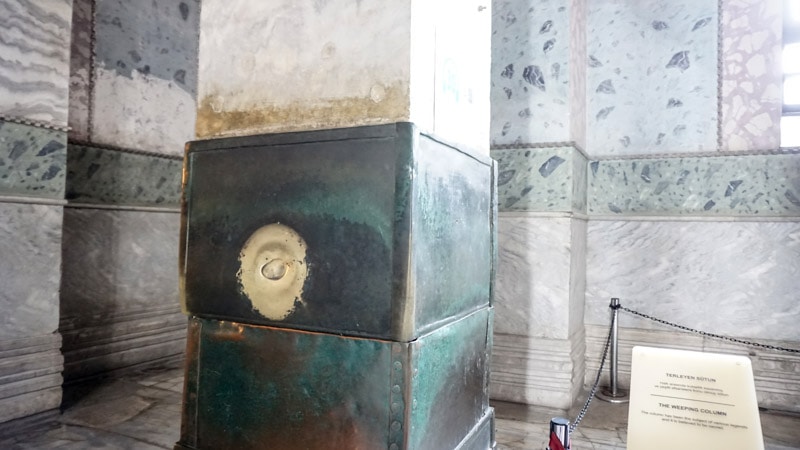
This strange looking indentation on the column is known as the Column of St. Gregory or The Weeping Column.
For centuries, millions of visitors to the Hagia Sophia believed that this column “wept” holy water while curing diseases and afflictions. To this day, this column is still considered holy, evident by the lines of visitors that queue for the opportunity to touch the column.
Visitors to the column “cure their ailments” by placing their thumbs in the hole of the column and spinning their hand in a 360-degree circle. If your thumb comes out feeling damp, then your prayers will be answered.
Exit the door to the left of the column and make a right and head up the long, stone paved ramp up to the Upper Galleries.
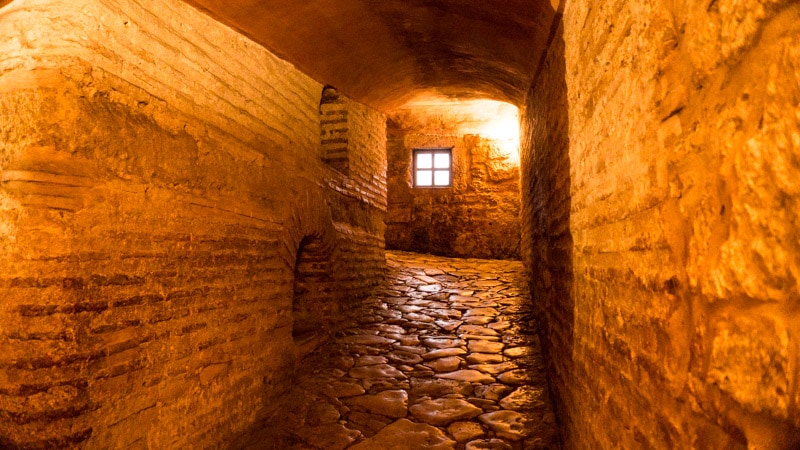
This stone paved ramp leads to the upper galleries, which holds some of Hagia Sophia’s most famous mosaics.
High ranking officials and the emperor were carried by servants up this ramp. It was also not uncommon for them to ride their horses up the ramp.
From the top of the ramp turn right then left and continue down towards the end. Pass through the “Gate of Heaven and Hell” where you can view the Deesis Mosaic.
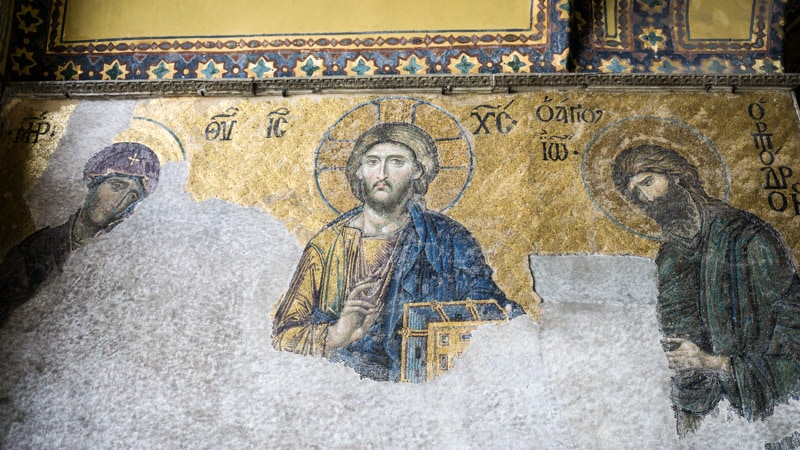
Though not the best preserved, the Deesis Mosaic is one of the finest examples of Hagia Sophia’s Byzantine Empire mosaics. The detail of the faces and workmanship is stunning. If you can, try to get a close up view of the intricate details of the mosaic.
Dating back to the 13th or 14th century, the Deesis Mosaic portrays the Virgin Mary on the left and John the Baptist on the right asking Jesus for the salvation of souls. This type of mosaic is common in Eastern Orthodox churches.
With your back facing the Deesis Mosaic, walk towards the end of the gallery to view another amazing mosaic known as the Mosaic of the Virgin and Child with Emperor John Comnenus and Empress Irene.
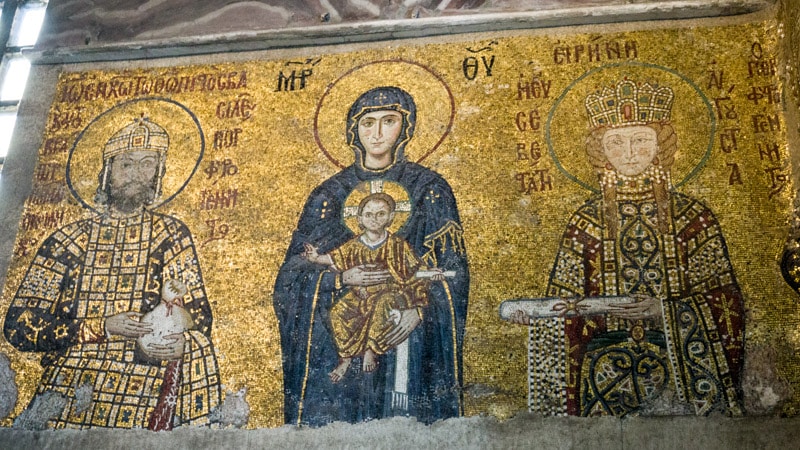
At the end of the south gallery is the 12th century Mosaic of the Virgin and Child with Emperor John Comnenus and Empress Irene.
At the center of the mosaic is Mary who is holding Christ Child in her arms. If you look closely, you can see Christ’s right hand extending in blessing. In his left hand he holds a scroll.
To the left of Jesus is the emperor who holds a bag of money for Jesus. This gesture represents the emperors patronage for Christ. To the right, the empress holds a scroll.
This completes your tour of the Hagia Sophia.
Last Updated on January 1, 2024
Related Posts